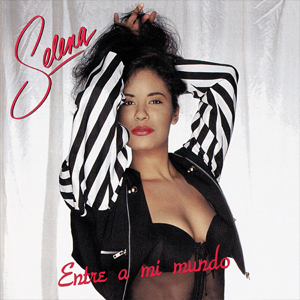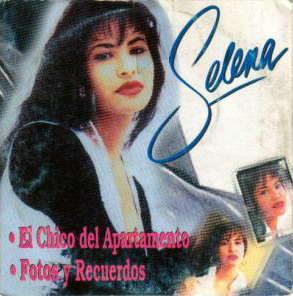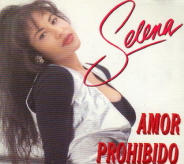
Selena Quintanilla Pérez, known mononymously as Selena, was an American Tejano singer. Called the "Queen of Tejano music", her contributions to music and fashion made her one of the most celebrated Mexican-American entertainers of the late 20th century. In 2020, Billboard magazine put her in third place on their list of "Greatest Latino Artists of All Time", based on both Latin albums and Latin songs chart. Media outlets called her the "Tejano Madonna" for her clothing choices. She also ranks among the most influential Latin artists of all time and is credited for catapulting the Tejano genre into the mainstream market.

Amor Prohibido is the fourth studio album by American singer Selena, released on March 13, 1994, by EMI Latin. Having reached a core fan base, the label aimed to broaden her appeal with the next studio release. Finding it challenging to write a follow-up hit after "Como la Flor" (1992), Selena's brother A. B. Quintanilla enlisted the assistance from band members Ricky Vela and Pete Astudillo with writing the album's songs. The resulting album has a more mature sound featuring experimental production that blends diverse musical styles from ranchera to hip-hop music. Amor Prohibido is a Tejano cumbia album modernized with a synthesizer-rich delivery using a minimalist style that was quintessential in early 1990s Tejano music.

Ven Conmigo is the second studio album by American singer Selena, released on October 6, 1990, by EMI Latin. The singer's brother, A.B. Quintanilla III remained her principal record producer and songwriter after her debut album's moderate success. Selena's Los Dinos band composed and arranged seven of the album's ten tracks; local songwriter Johnny Herrera also provided songs for Selena to record. Ven Conmigo contains half cumbias and half rancheras, though the album includes other genres. Its musical compositions are varied and demonstrate an evolving maturity in Selena's basic Tejano sound. The album's structure and track organization were unconventional compared with other Tejano music albums. The songs on Ven Conmigo are mostly love songs or songs following a woman's struggles after many failed relationships.

Entre a Mi Mundo is the third studio album by American singer Selena, released on May 6, 1992, by EMI Latin. In his recording debut with Selena y Los Dinos, guitarist Chris Pérez had fallen in love with Selena—which Selena's father and manager of the group, Abraham Quintanilla, Jr., disapproved of—and Pérez and Selena eloped on April 2, 1992, after Abraham fired Pérez from the band. Abraham later apologized, accepted Pérez and Selena's relationship, and accepted Pérez as a member of the band. Selena's brother and music producer, A.B. Quintanilla, oversaw production of Entre a Mi Mundo. A.B. also composed most of the tracks on the album along with band members Ricky Vela and Pete Astudillo. The group members' diverse backgrounds aided in the diversity of the genres explored on Entre a Mi Mundo, making it the band's most innovative recording. It includes music genres ranging from synthesized, Tejano and Mexican cumbia to R&B and rock music.

Live! or Selena Live! is a live album by American Tejano pop singer Selena, which was released on May 4, 1993 by EMI Latin. The album was re-released on September 22, 2002 as being part of the Selena: 20 Years of Music collection; which included spoken liner notes by her family, friends and her former band members Selena y Los Dinos. Live! includes three cumbia-influenced studio tracks, while the rest of the album consists of live versions of previously released songs. The album was recorded during a free concert at the Memorial Coliseum in Corpus Christi, Texas, on February 7, 1993. It was certified gold by the Recording Industry Association of America in its first year, double platinum in 1995, and gold (standard) in 2002.
American singer Selena released six studio albums, three live albums, three boxsets, one remix album, two soundtrack albums, and twenty compilation albums. Credited for elevating a music genre into the mainstream market, Selena remains the best-selling Tejano recording artist whose posthumous releases continue to outsell those of living musicians. Selena has sold 18 million units worldwide, making her one of the best-selling artists in Latin music. She was named the top-selling Latin artist of the 1990s decade by Billboard magazine.

Siempre Selena is the second posthumously released album by American singer Selena, released by EMI Latin on October 29, 1996. The album contained mostly unreleased recordings and remixes of previously released content. Songs on the album range from a 14-year-old Selena on "Soy Amiga" (1986) to the shelved Don Juan DeMarco (1995) soundtrack song "Siempre Hace Frio". Siempre Selena was a result of the impact of Selena's death in March 1995, where the singer's father and manager Abraham Quintanilla Jr. began receiving requests from fans of her music. Abraham rediscovered forgotten tapes of songs Selena recorded for various projects. Following her death, Abraham expressed how he wanted to keep the singer's legacy alive and that public knowledge of Selena was very important to him. Critical reception of Siempre Selena was mixed, with varying reviews suggesting that the album was more for Selena's fan base and found no particular track on the album to be of any interest, while others favored its diversity and remastered songs.

All My Hits: Todos Mis Éxitos is a greatest hits album by American singer Selena. It was released posthumously on March 9, 1999, through EMI Latin to commemorate its ten-year anniversary since entering the music industry. The album coincided with the fourth anniversary of Selena's death, though then-president Jose Behar rebuffed the idea that the album was an exploitive ploy by the company. Following Selena's death on March 31, 1995, Abraham Quintanilla expressed his interest in persevering his daughter's memory through her works. Selena's family has been criticized by fans and the media for exploiting the singer and cannibalizing her murder by commercializing her repertoire. According to the singer's brother, A.B. Quintanilla, one of Selena's wishes was for her to "never go away", citing a conversation he shared with Selena and their sister Suzette Quintanilla, that if anything were to happen to any one of them, their wish would be to continue on with their music.

All My Hits: Todos Mis Éxitos Vol. 2 is a greatest hits album by American singer Selena and was released posthumously on February 29, 2000, through EMI Latin. In 1999, Selena remained EMI Latin's top-selling artist and outsold living musicians with her releases. President of EMI Latin Jose Behar, who discovered the singer at the 1989 Tejano Music Awards, recognized Selena for her contributions that made EMI Latin "the house that Selena built". To commemorate the label's tenth anniversary, they released All My Hits: Todos Mis Éxitos in March 1999 to commercial success and announced a follow-up. All My Hits: Todos Mis Éxitos Vol. 2 contains songs ranging from recordings found on Selena's Munequito de Trapo (1987) to the posthumous 1997 club remix of "Enamorada de Ti" (1990). Following Selena's death, her father Abraham Quintanilla expressed his interest in persevering his daughter's memory through her works. Selena's family has been criticized by fans and the media for exploiting the singer and cannibalizing her murder by commercializing her repertoire.

Momentos Intimos is a compilation album by American singer Selena and released posthumously on March 23, 2004, through EMI Latin. The album contains 24 tracks, though the last eight are spoken liner notes provided by the singer's family, friends, and her Los Dinos band. The songs on the album range from "Como Te Quiero Yo a Ti" (1988), a re-recorded version modernized and remixed on the album, to "Puede Ser", an unreleased duet with Nando "Guero" Dominguez, recorded two weeks before Selena was shot and killed in March 1995. Following Selena's death, her father Abraham Quintanilla expressed his interest in persevering his daughter's memory through her works. Selena's family has been criticized by fans and the media for exploiting the singer and cannibalizing her murder by commercializing her repertoire.

"No Me Queda Más" is a song by American singer Selena on her fourth studio album, Amor Prohibido. It was released as the third single from the album in October 1994 by EMI Latin. "No Me Queda Más" was written by Ricky Vela, and production was handled by Selena's brother A.B. Quintanilla. A downtempo mariachi and pop ballad, "No Me Queda Más" portrays the ranchera storyline of a woman in agony after the end of a relationship. Its lyrics express an unrequited love, the singer wishing the best for her former lover and his new partner.

"Fotos y Recuerdos" is a song recorded by American recording artist Selena for her fourth studio album, Amor Prohibido (1994). It was released by EMI Latin in January 1995, as the fourth single. A cover version of the Pretenders' 1983 single "Back on the Chain Gang", "Fotos y Recuerdos" was written by Chrissie Hynde with Spanish-language lyrics by Ricky Vela. Lyrically, the song describes a lonely female protagonist who "kisses the photo of her [lover] each night before falling asleep."

"Amor Prohibido" is the title song of American Tejano singer Selena's fourth studio album of the same name (1994). Released as the lead single through EMI Latin on April 13, 1994, it was written by Selena, her brother and music producer A. B. Quintanilla, and her band's backup vocalist Pete Astudillo. "Amor Prohibido"'s lyrical themes have been analyzed by authors, musicologists, and journalists, who found them relevant to issues facing the LGBT community. A popular interpretation compares it to Romeo and Juliet.

"Como la Flor" is a song that was recorded by American singer Selena for her third studio album Entre a Mi Mundo (1992). It was written by A. B. Quintanilla and Pete Astudillo. The song was conceptualized in 1982 after A. B. saw a family selling illuminated plastic flowers at a concert in Sacramento, California. In 1992, an infectious melody stuck in A. B's head; he ran from the shower of their hotel room in Bryan, Texas, pulled out a keyboard, and immediately began working on it with Astudillo. It took A. B. 20 minutes to complete the music and took Astudillo another hour to complete the lyrics. It is an up-tempo, Tejano cumbia torch song that fuses tropical and cumbia rhythms with reggae and pop music. In the song's lyrics, the female protagonist addresses her former lover, who abandoned her for another partner. The narrator is unsure of her ability to love again, though wishing her former partner and his new lover the best.

"Si Una Vez" is a song recorded by American recording artist Selena for her fourth studio album, Amor Prohibido (1994). It was written by Pete Astudillo and produced by Selena's brother-producer A.B. Quintanilla. "Si Una Vez" is a mariachi fusion song and draws influence from cumbia and Latin dance music. Lyrically, Selena questions why she ever fell in love with an abusive partner, saying she will never repeat her mistakes. The lyrics suggest unrequited love and female empowerment.
American singer Selena released twenty-four official singles, seven promotional singles. Her career began as the lead vocalist of Los Dinos in 1980. Her albums with Los Dinos on indie labels failed to achieve any chart success. In 1987, her remake of Ritchie Valens' "La Bamba" peaked at number 19 on the United States Billboard Hot Latin Songs chart, her first entry. She signed with EMI Latin nine years later as a solo artist though her band continued to tour with her. Selena appeared on "Buenos Amigos" with Salvadoran singer Álvaro Torres. The track peaked at number one on the U.S. Hot Latin Songs chart in 1991, the singer's first number one song. Subsequent singles, "Baila Esta Cumbia" and "Como la Flor", became popular songs on Mexican radio, with "Como la Flor" launching the singer's career in that country. "Como la Flor" peaked at number six on the Hot Latin Songs chart, despite popular culture claims that it was the singer's first number one single. The track has charted on the U.S. Regional Mexican Digital Songs list since its inception in 2010 and remains the singer's signature number and most popular recording.

The Barrio Boyzz were an American Latin pop group. The group was made up of Puerto Ricans who grew up in New York City. They gained popularity during the 1990s, when they became label-mates with Selena Quintanilla then landed their first Billboard number-one song entitled "Donde Quiera Que Estés" in 1993, from the album of the same name.

Enamorada de Ti is the second remix album by American Tejano singer Selena. It was released posthumously on 3 April 2012 through Capitol Latin and Q-Productions. Enamorada de Ti was produced by Sergio Lopes, Leslie Ahrens, Andres Castro, Moggie Canazio, Cesar Lemons and Chilean record producer Humberto Gatica. Gatica had the idea of modernizing songs recorded by Selena into today's popular music genres. Selena's family had already been working on a similar idea, but they set it aside in favor of Enamorada de Ti, which had gained the approval of Capitol Latin. The selection of artists to sing duets with Selena began in late summer 2011. Gatica and Selena's family chose American singer and actress Selena Gomez, Puerto Rican singer Don Omar, Samuel "Samo" Parra from the Mexican rock band Camila, Mexican singer Cristian Castro, Spanish DJ mixer Juan Magan, and the Carlos Santana band, while the remaining songs selected were remixed.

















